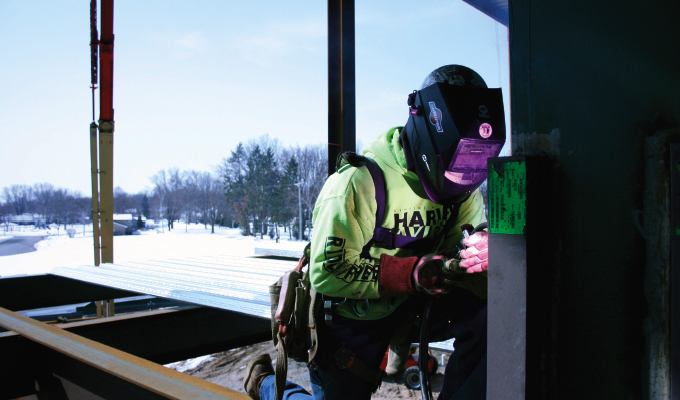Self-shielded flux-cored arc welding (FCAW-S) offers numerous benefits, including good weldability, high deposition rates, and excellent chemical and mechanical properties. These make the process a common choice for many applications, such as structural steel erection, bridge construction, and heavy equipment repair. But like any welding process, it is not without its challenges.
There are a few simple tips and best practices that can help address these challenges. Using this knowledge—with a bit of practice—can save time, money and frustration, and help achieve high weld quality.
SLAG INCLUSIONS
Slag inclusions—the result of molten flux from inside the welding wire becoming trapped inside the weld—can commonly occur in out-of-position and multi-pass FCAW-S applications. Preventing this issue depends on following key best practices and utilizing proper welding techniques. These include:
Maintain correct travel speed and angle. When welding in the vertical-up position, use a drag angle of between 5 and 15 degrees for the gun. Use a drag angle of 15 to 45 degrees when welding in the flat or horizontal positions. Increase this angle as necessary if the problem persists. Also maintain a steady travel speed, as moving too slowly can cause the weld puddle to get ahead of the arc and create slag inclusions.
Maintain proper heat input by always using the filler metal manufacturer’s recommended voltage for the specific wire diameter. Too little heat input can result in slag inclusions.
Clean the material thoroughly between weld passes to remove slag.
Be sure to correctly place the weld bead. Allow enough space in the weld joint—especially during root passes and wide groove openings—for the weld metal to fill it.
POROSITY, WORMTRACKING
Porosity is a common weld defect that occurs when gas is trapped in the weld. Cleaning the base material thoroughly prior to welding is the main way to prevent this problem.
Remove all dirt, rust, grease, oil, paint, moisture, and other contaminants from the full length of the weld joint. While welding, be sure to maintain wire stick-out of no more than 1.25 inches beyond the contact tip. In addition, using filler metals containing added deoxidizers can help prevent porosity and allow for welding through light contaminants. However, these wires are not a replacement for proper cleaning.
Another defect, wormtracking, refers to marks on the surface of the weld bead caused by gas that the flux inside the wire creates. Take care to avoid excessive voltage for the wire feed setting to help prevent this problem. In situations where wormtracking occurs, reduce the voltage in increments of 1/2 volt until the problem stops.
UNDERCUTTING, LACK OF FUSION
Two additional defects affecting weld quality are lack of fusion and undercutting. Preventing these issues can help save time and money in rework and downtime.
Lack of fusion occurs when the weld metal does not properly fuse with the base material or with the preceding weld bead during multi-pass welding. Using an improper gun angle is the main cause of this problem. Maintain heat input and correct work angle of the gun to help prevent lack of fusion. Use a gun angle drag of 15 to 45 degrees, and keep the arc on the trailing edge of the welding puddle. When using a weaving technique, hold the arc on the groove’s sidewall.
A dirty work surface is another common cause of lack of fusion. Proper and thorough cleaning of the surface before welding and in between passes is recommended.
Undercutting causes a weaker area at the toe of the weld by allowing a groove to melt in the base metal that is not filled in by the weld metal. This defect can often lead to cracking. To prevent undercutting, follow welding parameters for the appropriate welding current and voltage. Gun angle also plays a key role in this issue. In addition, be sure to maintain a travel speed that allows the weld metal to fill the melted-out areas of the base material completely.
PROBLEMS WITH PENETRATION
When it comes to weld joint penetration, too much and too little are both problematic. Good joint penetration is critical to completing high-quality welds, so it’s important to pay attention to how much weld metal is going into the joint.
When weld metal melts through the base metal and hangs underneath the weld, this is excessive penetration. It is most often caused by too much heat. Avoid this problem by maintaining proper heat input for the application. Lower the voltage range, reduce wire feed speed and increase travel speed.
When the problem is a lack of penetration—or a shallow fusion between the weld and base metals—taking the opposite steps will help: increase the voltage range and wire feed speed, while reducing travel speed.
Joint preparation also plays a role in proper penetration. To maintain the right wire extension and obtain necessary arc characteristics for good weld quality, it is imperative to access the bottom of the groove.
CLOSING THOUGHT
As with any welding process, FCAW-S can present some challenges. By utilizing proper welding technique and taking steps to address the issues, it will be easier to identify and solve problems quickly—or even prevent them from occurring—in order to reap the productivity and quality benefits the process offers.
About the Author:
Jerome Parker is a product manager with Bernard. For more, visit www.bernardwelds.com.
Modern Contractor Solutions, April 2022
Did you enjoy this article?
Subscribe to the FREE Digital Edition of Modern Contractor Solutions magazine.



